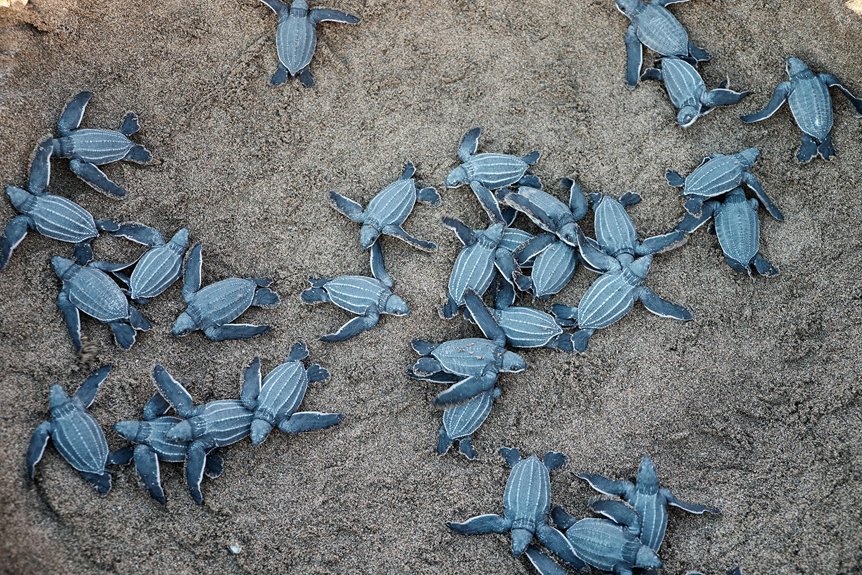You’ll discover Cyprus’s premier turtle nesting tours through SPOT’s scientifically guided expeditions across the Akamas Peninsula. Explore loggerhead and green sea turtle habitats during late May to July, experiencing controlled beach environments where endangered species reproduce. Guided tours range from 3-4 hour experiences starting around $77, offering intimate wildlife observations while supporting critical marine conservation efforts. Intriguing details await your exploration.
Principales conclusiones
- SPOT Conservation Tours offer immersive 3-9 hour guided experiences along North Cyprus’s premier turtle nesting beaches like Alagadi and Golden Beach.
- Peak nesting season tours from late May to late July provide unparalleled opportunities to observe loggerhead and green turtle reproductive behaviors.
- Expert-led expeditions cost approximately $77 per person, featuring scientific insights, specialized coastal vehicle access, and minimal environmental disruption.
- Guided tours contribute directly to conservation efforts by supporting egg protection, beach monitoring, and habitat preservation for endangered sea turtle populations.
- Photography and documentation opportunities allow participants to engage with marine wildlife while learning about critical sea turtle reproduction and conservation strategies.
Discovering Akamas: Cyprus’s Premier Sea Turtle Habitat
While the Akamas Peninsula stands as a crown jewel of Cyprus’s ecological landscape, it’s particularly renowned for its critical sea turtle nesting grounds. You’ll find this protected area hosts two primary sea turtle species: the loggerhead (Caretta caretta) and green sea turtles, which annually migrate to these pristine beaches for reproductive cycles.
Guided turtle nesting tours in Akamas offer you an unparalleled opportunity to observe these marine reptiles in their natural habitat. Scientists and local conservation experts lead these expeditions, providing detailed insights into turtle behavior, nesting patterns, and ecological significance. You’ll witness females emerging from the Mediterranean’s waters, carefully selecting favorable nesting sites along sandy shorelines.
These tours typically occur during peak nesting season-between May and August-when female turtles emerge under moonlit nights to lay approximately 100 eggs per nest. By participating, you’re not just observing; you’re contributing to critical conservation efforts protecting these endangered marine species.
Turtle Species of North Cyprus: Green and Loggerhead Turtles
The Mediterranean waters surrounding North Cyprus harbor two remarkable sea turtle species: the robust Loggerhead (Caretta caretta) and the graceful Green Turtle (Chelonia mydas). These ancient marine reptiles have found a pivotal nesting sanctuary along the island’s pristine beaches, making North Cyprus a fundamental conservation zone.
| Especie | Weight | Unique Characteristic | Nesting Behavior |
|---|---|---|---|
| Caguama | Up to 450 kg | Large, powerful head | Multiple nests per season |
| Tortuga verde | Lighter weight | Navigation to birth beach | Precise nesting location |
The Society for the Protection of Turtles (SPOT) monitors these endangered species during their essential laying and hatching seasons. Loggerhead Turtles, known for their substantial size, and Green Turtles, recognized for their extraordinary navigational abilities, represent the primary turtle populations in this Mediterranean ecosystem. Their presence underscores the ecological significance of North Cyprus’s coastal environments, highlighting the importance of ongoing conservation efforts to protect these remarkable marine inhabitants.
Nesting Season Insights: When and Where to Observe
Situated along the Mediterranean coastline, North Cyprus offers a remarkable window into sea turtle nesting dynamics during an intense two-month reproductive period. From late May to late July, you’ll witness female loggerhead and green turtles traversing Alagadi Beach, Golden Beach, and Akamas Peninsula to deposit their eggs. These strategic locations provide critical nesting grounds for endangered turtle populations.
During this window, females meticulously excavate nests and lay between 70 and 150 eggs, carefully burying them in the warm coastal sand. The incubation period spans approximately 50 to 60 days, with hatchlings emerging between August and late September. The Society for the Protection of Turtles (SPOT) monitors these sites, ensuring the safety and success of each nesting attempt.
Your observation opportunities are best during twilight and early evening hours when turtles are most active, providing an intimate glimpse into their remarkable reproductive cycle.
Conservation Efforts: Protecting Cyprus’s Marine Treasures
Safeguarding sea turtle populations requires intricate, strategic conservation methodologies that extend far beyond casual observation. The Society for the Protection of Turtles (SPOT) demonstrates this approach by implementing thorough protection strategies across North Cyprus’s critical nesting habitats.
You’ll find that conservation efforts involve meticulous egg protection techniques, including strategic cage deployments at key sites like Alagadi Beach and Golden Beach. Volunteer teams and marine biology students conduct systematic beach patrols, collecting critical data during nesting and hatching seasons. These interventions directly address threats to loggerhead and green turtle survival.
SPOT’s monitoring protocols are scientifically rigorous, focusing on precise documentation and protective measures. By creating controlled environments for egg incubation and minimizing human disturbance, conservation teams guarantee ideal conditions for hatchling survival. Their work represents a critical intervention in preserving these ancient marine species, transforming potentially vulnerable nesting sites into sanctuaries of reproductive success.
Guided Tour Options: Quad, Buggy, and Jeep Experiences
Ever wondered how to explore Cyprus’s pristine turtle nesting landscapes beyond traditional walking tours? Quad, buggy, and Jeep tours offer adventurous access to remote coastal regions where sea turtles breed. These off-road experiences navigate challenging terrains in the Akamas Peninsula, providing intimate encounters with critical nesting habitats.
Tour options range from 3-4 hour expeditions to extensive 8-9 hour journeys, with prices starting around $77 per person. Specialized vehicles like Land Rovers and quad bikes enable you to traverse rugged landscapes, reaching secluded sites like Lara Bay and Turtle Bay. Professional guides navigate you through delicate ecosystems, ensuring minimal environmental disruption while maximizing wildlife observation opportunities.
Key destinations include sea caves, waterfalls, and strategic beach locations where turtle nests are concentrated. These immersive tours not only offer thrilling off-road experiences but also provide scientific insights into marine turtle conservation, allowing you to witness these remarkable creatures in their natural habitat.
Top Turtle-Watching Beaches in the Akamas Peninsula
After traversing the rugged terrain of Cyprus’s coastal landscapes, nature enthusiasts will discover the Akamas Peninsula’s most remarkable turtle nesting beaches. Lara Beach stands out as a critical habitat for endangered Loggerhead and Green sea turtles, offering pristine nesting grounds meticulously monitored during the May to September breeding season.
Toxeftra Beach presents an exceptional observation site where visitors can witness mother turtles carefully depositing eggs in carefully selected sand locations. Alagadi Beach, locally known as Turtle Beach, provides the most thorough turtle-watching experience, with conservation volunteers guiding observers through the intricate nesting and hatching processes.
Each beach represents a unique ecological microcosm, supporting these ancient marine reptiles’ reproductive cycles. The careful management and protection of these sites guarantee minimal human interference while allowing scientifically controlled observation of these remarkable creatures’ natural breeding behaviors.
Responsible Wildlife Observation: Ethical Turtle Watching Guidelines
The five fundamental principles of ethical turtle watching serve as vital guidelines for responsible wildlife observation in Cyprus’s delicate marine ecosystems. You must prioritize minimal disturbance to nesting sites, maintaining a safe distance of at least 10 meters from turtles and their nests. Avoid using flash photography, which can disorient and stress marine reptiles during essential reproductive cycles.
When observing loggerhead and green sea turtles, you’ll want to move slowly, speak quietly, and prevent sand displacement near nesting areas. Professional guided tours can help you understand proper behavioral protocols. Your group should never touch eggs, hatchlings, or adult turtles, as human contact can introduce harmful bacteria and disrupt natural behaviors.
Crucial considerations include wearing neutral-colored clothing, staying on designated paths, and removing all personal trash from beach environments. By following these scientifically-informed guidelines, you’ll contribute to conservation efforts while experiencing Cyprus’s extraordinary marine wildlife responsibly.
Photography and Documentation: Capturing Turtle Moments
Building upon responsible wildlife observation practices, photographers seeking to document Cyprus’s marine turtle populations must approach their craft with scientific precision and minimal ecological interference. You’ll want to leverage specialized equipment like long lenses and tripods, which enable capturing intimate moments without disrupting natural behaviors.
Guided photography tours offer strategic vantage points for documenting nesting and hatching processes. Nighttime photography requires obtaining specific permits, ensuring both turtle safety and legal compliance. Professional photographers often partner with conservation organizations, using their visual narratives to educate and raise awareness about these critical marine species.
Critical technical considerations include utilizing silent shutter modes and avoiding flash photography, which can disorient turtles. Your goal isn’t just aesthetic documentation but contributing to scientific understanding. By meticulously recording turtle life cycles through ethical photographic techniques, you’ll help amplify conservation messaging and support ongoing research efforts.
Supporting Local Conservation: How Tourists Can Make a Difference
While marine turtle conservation might seem like a complex challenge, tourists visiting Cyprus can play a pivotal role in protecting these remarkable species. By participating in volunteer programs, you’ll directly contribute to monitoring and safeguarding vital turtle nesting sites during breeding seasons.
Your engagement extends beyond physical involvement. Purchasing locally crafted souvenirs or donating to organizations like the Society for the Protection of Turtles (SPOT) provides essential financial support for conservation initiatives. Mindful tourism practices are important-adhering to viewing guidelines and respecting designated observation areas minimizes potential disturbances to nesting turtles.
Furthermore, your advocacy matters. Spreading scientific awareness about turtle conservation challenges and ecological threats can inspire broader community involvement. Selecting eco-tourism operators committed to responsible, sustainable practices ensures your travel experience positively impacts local turtle populations.
Each tourist’s conscious actions can greatly influence marine turtle preservation efforts in Cyprus.
Preguntas frecuentes
Where’s the Best Place to See Turtles in Cyprus?
You’ll find Alagadi Beach in North Cyprus is the premier turtle-watching destination. Here, loggerhead and green turtles regularly nest, offering unparalleled observation opportunities. During peak season (May-August), you’ll witness remarkable nesting behaviors and hatchling journeys. Guided tours with SPOT can enhance your experience, providing expert insights into these marine reptiles’ complex reproductive cycles and conservation challenges. The beach’s carefully managed environment guarantees minimal human disturbance.
Where Is the Best Place to See Sea Turtles Nesting?
When nature calls, sea turtles answer! You’ll find prime nesting sites along North Cyprus’s coastline, particularly Alagadi Beach, where loggerhead and green turtles emerge under moonlit shores. Scientifically speaking, this region offers ideal nesting conditions with protected beaches, minimal human disturbance, and precise environmental parameters that support successful reproduction. Karpaz Peninsula’s Golden Beach and Caretta Beach also provide exceptional turtle observation opportunities.
What Month Can You See Turtles in Cyprus?
You’ll witness peak turtle activity in June and July, when loggerhead and green turtles nest along North Cyprus’s coastline. During these months, females lay 70-150 eggs per nest, with ideal viewing opportunities at beaches like Akamas and Alagadi. While nesting peaks in these summer weeks, hatchlings will emerge later in August and September, offering additional chances to observe these remarkable marine reptiles in their natural habitat.
What Month Is Best to See Sea Turtles?
You’ll find the ideal sea turtle viewing period in North Cyprus spans late July through September. During this timeframe, hatchlings emerge from their incubating nests, typically 50-60 days after egg-laying. Female loggerhead and green turtles complete their nesting cycle, and you’ll witness newly hatched turtles making their remarkable journey from sandy beaches to the Mediterranean Sea, representing a crucial moment in their reproductive strategy.
Conclusión
By coincidence, your turtle-watching journey in Cyprus aligns perfectly with critical conservation needs. You’ll discover that observing these magnificent marine creatures isn’t just tourism-it’s a scientific opportunity to understand delicate ecosystem interactions. As you witness nesting sea turtles in the Akamas Peninsula, you’re simultaneously contributing to their preservation. Every careful step you take supports research, protection, and the sustainable future of these remarkable reptilian inhabitants.

Natalie lleva 10 años viviendo en Chipre. Le encanta explorar la hermosa naturaleza de la isla, como sus tranquilos bosques y sus playas vírgenes. Natalie tiene muchas experiencias interesantes que compartir. Acompáñela y cuéntenos sus aventuras en Chipre.

